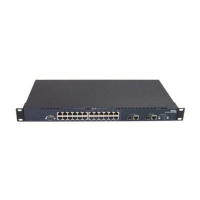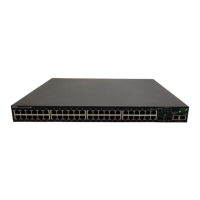BigIron RX Series Configuration Guide 453
53-1002253-01
Overview of VRRP
17
You can provide more redundancy by also configuring a second VRID with Router2 as the Owner and
Router1 as the Backup. This type of configuration is sometimes called Multigroup VRRP.
Master router election
Virtual routers use the VRRP priority values associated with each VRRP router to determine which
router becomes the Master. When you configure an Owner router, the device automatically sets the
its VRRP priority to 255, the highest VRRP priority. The router in the virtual router with the highest
priority becomes the Master. Other routers become the backup and can be assigned priorities 3 –
254. The default priority value is 100.
Virtual routers use VRID Hello messages to determine if a Master router is available. They send
Hello messages to IP Multicast address 224.0.0.18 at a specified frequency. The Backup routers
waits for a duration of time for a Hello message from the Master. This duration is called the Dead
Interval. If a Backup router does not receive a Hello message by the time the dead interval expires,
the Backup router assumes that the Master router is dead. the Backup router with the highest
priority becomes the Master router. Once the Owner router becomes available, it becomes the
Master router and the current Master router returns to being a backup router.
Pre-emption
If the pre-emption feature is enabled, a Backup router that is acting as the Master can be
pre-empted by another Backup router that has a higher priority. This can occur if you add a new
Backup while the Owner is still available and new Backup router has a higher priority than the
Backup router that is acting as Master.
Virtual router MAC address
When you configure a VRID, the software automatically assigns its MAC address as the virtual
router’s MAC address. The first five octets of the address are the standard MAC prefix for VRRP
packets, as described in RFC 3768. The last octet is the VRID. THE VRID number becomes the
final octet in the virtual router’s virtual MAC address. For example, the MAC address for VRID is
000.5e00.0101.
When the virtual router becomes the Master router, it broadcasts a gratuitous ARP request
containing the virtual router’s MAC address for each IP address associated with the virtual router.
In Figure 85, Router1 sends a gratuitous ARP with MAC address 00-00-5e-00-01-01 and IP address
192.53.5.1. Hosts use the virtual router’s MAC address in routed traffic they send to their default
IP gateway (in this example, 192.53.5.1).
Brocade enhancements of VRRP
Brocade enhanced VRRP by adding the following options:
• Track Ports and Track Priority
• Suppression of RIP Advertisements for Backed Up Interfaces
• Authentication
• VRRP’s operation is independent of RIP, OSPF, and BGP

